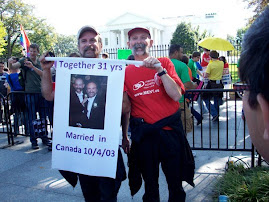OneNewsNow.com - Your News Right Now
BY ED VITAGLIANO, AFA Journal May 2008
Polling results from Gallup indicate that the public’s support for homosexuality continues to grow.
But all may not be lost for pro-family groups. A number of caveats indicate there is still a window of opportunity before America completely surrenders its traditional views on human sexuality, marriage and family.
After Gallup released its most recent survey on the issue in 2007, the polling firm said results found “current public tolerance for gay rights at the high-water mark of attitudes recorded over the past three decades.”
Soft support?
For instance, it appears when real-life events occur that get Americans talking about homosexuality, public acceptance of that lifestyle softens. As one example of this phenomenon, after the U.S. Supreme Court struck down state sodomy laws in the controversial Lawrence v. Texas decision in June 2003, support for homosexuality dropped dramatically.
The percentage of people who said “homosexual relations between consenting adults” should be legal stood at 60% in May 2003, while only 35% said such relations should not be legal. In July 2003, one month after Lawrence v. Texas, it was 48%-46% in favor of homosexual relations being legal. By January 2004 it had flipped: 49% of respondents to the Gallup survey said homosexual relations should be illegal, with 46% in favor of such relations being legal.
Gallup said the drop in support was connected to Lawrence v. Texas. “According to Gallup trends, that ruling appeared to produce a backlash of public opposition to gay rights,” the Gallup press release said last year.
Tim Wildmon, president of AFA, said, “I think this indicates that people only think about gay civil rights in the most general terms. When current events force people to think about homosexuality in concrete terms, they begin to waver in their support for the gay agenda.”
All in how you ask it
There is also a limitation to polling as a tool that plumbs the depths of feeling on any particular issue. Pollsters have long known, for instance, that asking leading questions or even the order in which questions are asked can subconsciously affect the answers given by respondents.
On the issue of same-sex marriage, for example, Gallup found in 2007 that 53% of people thought that homosexual marriage should not be allowed. Forty-six percent were in favor of it. Those responses were the closest ever found by Gallup.
To the company’s credit, however, Gallup issued this explanation in a press statement accompanying the release of poll results: “It should be noted that this gay marriage question follows a number of questions about homosexual rights [in Gallup’s survey]. … When the same question is asked in other Gallup surveys that do not include … [the other] questions, a lower level of support for gay marriage is usually found.”
In a previous poll in 2005 – in which the same-sex marriage question was not preceded by other questions on homosexuality – support was, in fact, lower. Just 39% said they were in favor of gay marriage, and 56% opposed.
This may indicate that there is a sense of public pressure at work, due to political correctness, when the subject of homosexuality surfaces. When people feel they are expected to answer in a certain way, they are more likely to yield to that expectation.
Nevertheless, there still appears to be a strong feeling in America that homosexuality is wrong, according to Gallup. Between 2001 and 2006, a slim majority of poll respondents (hovering between 51% and 55%) said they thought homosexual relations were “morally wrong.”
Public views on this have tightened somewhat. Support for the moral acceptability of gay relations grew from 40% in 2001 to 47% in 2007, while the belief that it was morally wrong dropped from 53% to 49%. And 2007 was the first year that a majority of Americans failed to call such relations morally wrong, although a plurality (49% to 47%) still did so.
How can it be that most Americans have believed homosexual relations to be morally wrong and yet, since 1999 (with the exception of the backlash to the Lawrence v. Texas decision) most have viewed homosexuality as publicly acceptable?
It appears that most Americans are conflicted over the issue – or at least, as previously stated, they may simply not be thinking about the matter in any serious way.
But this reality provides pro-family groups with an opportunity for influencing the “mushy middle” of American opinion that has not solidified either in full favor of or full opposition to gay rights. With public opinion trending in favor of the gay agenda, there is little time to lose.
Wednesday, April 16, 2008
Public acceptance of homosexuality grows
Subscribe to:
Post Comments (Atom)


No comments:
Post a Comment